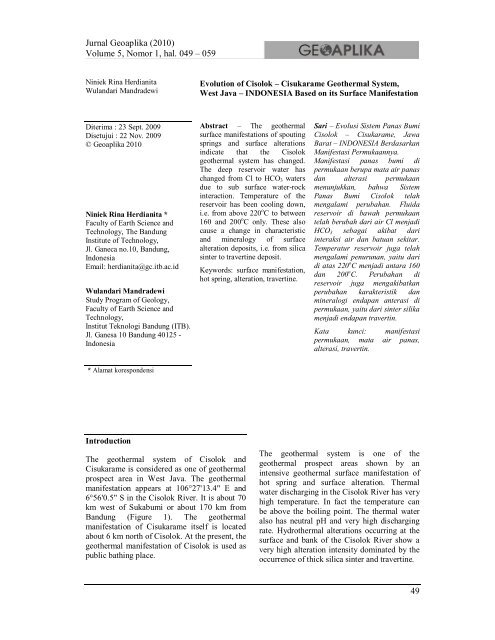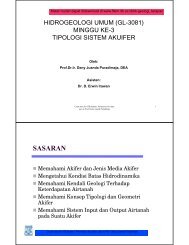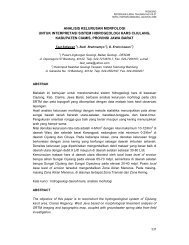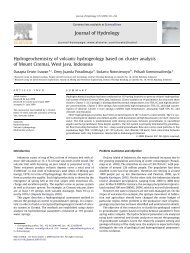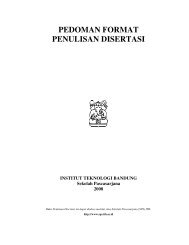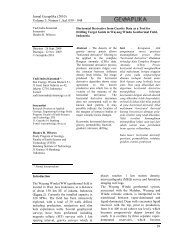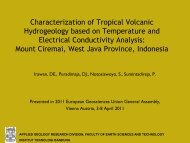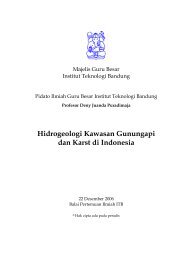Jurnal Geoaplika (2010) Volume 5, Nomor 1, hal. 049 â 059 49 - ITB
Jurnal Geoaplika (2010) Volume 5, Nomor 1, hal. 049 â 059 49 - ITB
Jurnal Geoaplika (2010) Volume 5, Nomor 1, hal. 049 â 059 49 - ITB
You also want an ePaper? Increase the reach of your titles
YUMPU automatically turns print PDFs into web optimized ePapers that Google loves.
<strong>Jurnal</strong> <strong>Geoaplika</strong> (<strong>2010</strong>)<br />
<strong>Volume</strong> 5, <strong>Nomor</strong> 1, <strong>hal</strong>. <strong>0<strong>49</strong></strong> – <strong>059</strong><br />
Niniek Rina Herdianita<br />
Wulandari Mandradewi<br />
Evolution of Cisolok – Cisukarame Geothermal System,<br />
West Java – INDONESIA Based on its Surface Manifestation<br />
Diterima : 23 Sept. 2009<br />
Disetujui : 22 Nov. 2009<br />
© <strong>Geoaplika</strong> <strong>2010</strong><br />
Niniek Rina Herdianita *<br />
Faculty of Earth Science and<br />
Technology, The Bandung<br />
Institute of Technology,<br />
Jl. Ganeca no.10, Bandung,<br />
Indonesia<br />
Email: herdianita@gc.itb.ac.id<br />
Wulandari Mandradewi<br />
Study Program of Geology,<br />
Faculty of Earth Science and<br />
Technology,<br />
Institut Teknologi Bandung (<strong>ITB</strong>).<br />
Jl. Ganesa 10 Bandung 40125 -<br />
Indonesia<br />
Abstract – The geothermal<br />
surface manifestations of spouting<br />
springs and surface alterations<br />
indicate that the Cisolok<br />
geothermal system has changed.<br />
The deep reservoir water has<br />
changed from Cl to HCO 3 waters<br />
due to sub surface water-rock<br />
interaction. Temperature of the<br />
reservoir has been cooling down,<br />
i.e. from above 220 o C to between<br />
160 and 200 o C only. These also<br />
cause a change in characteristic<br />
and mineralogy of surface<br />
alteration deposits, i.e. from silica<br />
sinter to travertine deposit.<br />
Keywords: surface manifestation,<br />
hot spring, alteration, travertine.<br />
Sari – Evolusi Sistem Panas Bumi<br />
Cisolok – Cisukarame, Jawa<br />
Barat – INDONESIA Berdasarkan<br />
Manifestasi Permukaannya.<br />
Manifestasi panas bumi di<br />
permukaan berupa mata air panas<br />
dan alterasi permukaan<br />
menunjukkan, bahwa Sistem<br />
Panas Bumi Cisolok telah<br />
mengalami perubahan. Fluida<br />
reservoir di bawah permukaan<br />
telah berubah dari air Cl menjadi<br />
HCO 3 sebagai akibat dari<br />
interaksi air dan batuan sekitar.<br />
Temperatur reservoir juga telah<br />
mengalami penurunan, yaitu dari<br />
di atas 220 o C menjadi antara 160<br />
dan 200 o C. Perubahan di<br />
reservoir juga mengakibatkan<br />
perubahan karakteristik dan<br />
mineralogi endapan anterasi di<br />
permukaan, yaitu dari sinter silika<br />
menjadi endapan travertin.<br />
Kata kunci: manifestasi<br />
permukaan, mata air panas,<br />
alterasi, travertin.<br />
* Alamat korespondensi<br />
Introduction<br />
The geothermal system of Cisolok and<br />
Cisukarame is considered as one of geothermal<br />
prospect area in West Java. The geothermal<br />
manifestation appears at 106°27'13.4" E and<br />
6°56'0.5" S in the Cisolok River. It is about 70<br />
km west of Sukabumi or about 170 km from<br />
Bandung (Figure 1). The geothermal<br />
manifestation of Cisukarame itself is located<br />
about 6 km north of Cisolok. At the present, the<br />
geothermal manifestation of Cisolok is used as<br />
public bathing place.<br />
The geothermal system is one of the<br />
geothermal prospect areas shown by an<br />
intensive geothermal surface manifestation of<br />
hot spring and surface alteration. Thermal<br />
water discharging in the Cisolok River has very<br />
high temperature. In fact the temperature can<br />
be above the boiling point. The thermal water<br />
also has neutral pH and very high discharging<br />
rate. Hydrothermal alterations occurring at the<br />
surface and bank of the Cisolok River show a<br />
very high alteration intensity dominated by the<br />
occurrence of thick silica sinter and travertine.<br />
<strong>49</strong>
Figure 1. Map of West Java and Banten showing the location of the<br />
study area, i.e. at Cisolok, Sukabumi.<br />
Type and characteristic of its surface<br />
manifestation indicate that the geothermal<br />
system of Cisolok and Cisukarame has a<br />
s<strong>hal</strong>low reservoir having very high<br />
temperature. However, this geothermal potency<br />
has yet to be utilized, except for tourism. This<br />
is because, one of the reasons, the behavior of<br />
Cisolok and Cisukarame geothermal system is<br />
still unknown.<br />
A geothermal system including reservoir<br />
condition, type and sub surface flow pattern of<br />
thermal water can be understood by studying<br />
geothermal manifestations showing at the<br />
surface as hot spring, hot pool, steaming<br />
ground and hydrothermal surface alteration<br />
(Hochstein and Browne, 2000, and Browne,<br />
1978). By identification and correlation of an<br />
active and fossil geothermal system, the<br />
evolution of a geothermal system can be<br />
understood, including change in reservoir<br />
condition and sub surface flow pattern of<br />
thermal water.<br />
Geology<br />
Morphology of the study area can be divided<br />
into 3 parts, i.e. steep mountain, gentle<br />
mountain and plain. The steep mountain forms<br />
at northern and western parts of the study area.<br />
Its elevation is above 200 m with the slope of<br />
between 40 and 70. At the eastern part of the<br />
study area there is a zone of gentle mountain<br />
having elevation of less than 150 m and slope<br />
of less than 30. The last morphology zone is<br />
plain and occurs in south coastal area.<br />
Regional geology of the study area is shown by<br />
Sujatmiko and Santosa (1992). Cikotok<br />
formation is the oldest rock exposing in the<br />
western part of the study area. It has age of<br />
early Oligocene and consists of volcanic<br />
breccias, tuff and lava (Sujatmiko and Santosa,<br />
1992). It is overlain by early Miocene Citarete<br />
and Cimapag formations. The Citarete<br />
formation consists of limestone and tuff units,<br />
and the Cimapag formation is dominated by<br />
breccias and conglomerate (Sujatmiko and<br />
Santosa, 1992). Andesite and dacite then<br />
intrude the southern part of the study area<br />
during middle to late Miocene (Sujatmiko and<br />
Santosa, 1992). In the western part of the study<br />
area, igneous rock occurring is granodiorite to<br />
granite covered by dacitic lava and pyroclastic.<br />
Marine sediments and volcanic unit product of<br />
Citorek unconformably covered the Cikotok,<br />
Citarete and Cimapag formations during Plio-<br />
Pleistocene. Quaternary rocks of andesite and<br />
basaltic lavas product of Gunung Halimum and<br />
volcanic breccias and agglomerates product of<br />
Tapos then overlaid the area (Sujatmiko and<br />
50
Santosa, 1992). River alluvial and coastal<br />
deposit are the youngest deposit forming until<br />
now.<br />
Structural geology found in the study area is E-<br />
W and N-S faults (Sujatmiko and Santosa,<br />
1992). These faults are old, formed likely at<br />
Plio-Pleistocene and have been covered by<br />
Quaternary volcanic deposit.<br />
Surface Manifestations<br />
Resistivity survey of Hochstein (1988)<br />
indicates that the study area is an outflow zone<br />
indicated by low resistivity value along the<br />
Cisolok river. The study also indicates that the<br />
Cisolok and Cisukarame are one geothermal<br />
system that relates each other. The different in<br />
the resistivity value indicates that the Cisolok<br />
area consists of more permeable rocks<br />
compared to the Cisukarame area. This is likely<br />
due to the occurrence of limestone of Citarete<br />
formation below Cisolok.<br />
Geothermal manifestations of Cisolok occur in<br />
the surface as hot springs emerging in the<br />
Cisolok river with temperatures above the<br />
boiling point. This thermal water has neutral<br />
pH. Along the river bank around the hot spring,<br />
there is hydrothermal surface alteration<br />
dominated by silica sinter and travertine.<br />
Another surface manifestation occurs in<br />
Cisukarame, i.e. about 6 km north of Cisolok<br />
(Sujatmiko and Santosa, 1992). Based on<br />
resistivity survey of Hochstein (1988), these all<br />
manifestations are a geothermal system having<br />
one similar reservoir and likely relate to<br />
volcanic activity of Gunung Halimun or Salak.<br />
Hot spring<br />
At least there are 6 hot springs discharging<br />
continuously in Cisolok river (Figure 2).<br />
Hochstein (1994) named this manifestation as<br />
spouting springs that occur under artesian<br />
condition. Cisolok thermal water has<br />
temperature of between 90 and 100C, pH of<br />
about 8 and very high flow rate. The<br />
discharging thermal water then mixes with<br />
stream water having temperature of about 28C<br />
and forms a 34C mixed water. One of six hot<br />
springs in Cisolok has been collected in a pond.<br />
The water samples were taken at CSL-01, i.e.<br />
the northern most hot spring in Cisolok river,<br />
and the pond hot water of CSL-07.<br />
Figure 2. Geological traverse along the geothermal surface manifestation of Cisolok.<br />
51
Table 1. Result of chemical analyses of Cisolok and Cisukarame hot springs. Data from<br />
Priadi and Herdianita (2005) is given for comparison.<br />
Sample Number<br />
Parameter Unit Priadi and<br />
CSL-01<br />
Herdianita (2005)<br />
CSL-07 CRM<br />
Temperature<br />
o C 87 103 90 46<br />
pH - 6.9 8.3 7.9 7.7<br />
pH (lab,25°C) - 7.00 7.24 8.32 8.48<br />
TDS mg/L - 3360 1510 118<br />
EC S/cm - 4800 2160 164<br />
Ca 2+ mg/L - 68.82 50.05 1.19<br />
Mg 2+ mg/L - 28.10 8.34 2.52<br />
Cl - mg/L 284.00 369.86 369.86 6.73<br />
F mg/L - 1.033 1.033 0.290<br />
SO 4<br />
2-<br />
mg/L 609.02 268.04 187.45 12.52<br />
Na + mg/L - 1022.59 325.37 79.05<br />
K + mg/L - 77.33 24.92 0.52<br />
Fe mg/L - 0.144 0.093 -<br />
B mg/L - 0.000 0.072 0.003<br />
NH 4 mg/L - 0.475 0.673 -<br />
SiO 2 mg/L 159.69 12.22 13.55 20.19<br />
CO 3<br />
2-<br />
HCO 3<br />
-<br />
mg/L - 28.64 6.51 16.38<br />
mg/L 142.56 1416.36 201.20 154.64<br />
As 3+ mg/L 0.4 0.0414 0.0476 0.0094<br />
Li + mg/L - 0.179 0.175 0.014<br />
Anion - - 39.23 17.63 2.98<br />
Cation - - 52.20 17.97 3.72<br />
Anion-Cation % - 14.19 0.96 10.94<br />
Cl/Mg - - 20.39 68.71 4.14<br />
Mg/Ca - - 0.30 0.12 1.54<br />
Na/Mg - - 87.02 93.29 75.01<br />
Ca/Mg - - 1.47 3.60 0.28<br />
Na/K - - 22.42 22.14 257.78<br />
HCO 3 /SO 4 - 0.15 3.36 0.68 7.85<br />
52
Total dissolved solid (TDS), electric<br />
conductivity (EC) and chemical composition of<br />
thermal water are given in Table 1. Figure 3<br />
shows that the CSL-01 thermal water is HCO 3<br />
type, whereas the CSL-07 water is Cl type.<br />
Compared to the CSL-01 water, the CSL-07<br />
thermal water has pH of weak basic, lower<br />
TDS and EC, and lower concentrations of<br />
alkalis and ferromagnesian. However, both<br />
CSL-01 and 07 waters have major cation of Na.<br />
In addition, because the CSL-07 thermal water<br />
contains more Cl than the CSL-01 water, the<br />
CSL-07 water has higher SiO 2 and more<br />
balance ratio of cation to anion. Table 1 and<br />
Figure 3 also show that the composition and<br />
type of the Cisolok thermal water given by<br />
Priadi and Herdianita (2005) slightly differ<br />
from this time. According to Priadi and<br />
Herdianita (2005), the Cisolok thermal water is<br />
SO 4 type having high SiO 2 concentration.<br />
Figure 3. Relative concentration of Cl - SO 4 -<br />
HCO 3 (in mg/L) of hot springs in the study<br />
area. Point 01 is sample CSL-01, 07 is sample<br />
CSL-07, and CRM is sample from<br />
Cisukarame. Point 2005 is taken from Priadi<br />
and Herdianita (2005) as comparison.<br />
Surface geothermal manifestation of<br />
Cisukarame is located about 6 km north of the<br />
Cisolok manifestation. A hot pool occurs in the<br />
middle of rice field in Cisukarame. The thermal<br />
water (CRM) has temperature of 46 o C and pH<br />
of about 7.7. Its flow rate is very low. The type<br />
and characteristic of warm water of<br />
Cisukarame are similar to CSL-01, i.e.<br />
dominated by major anion of HCO 3 and major<br />
cation of Na. No surface alteration is found<br />
around the hot pool, except a mixture of<br />
colloidal silica and organic material found in<br />
the water surface of hot pool.<br />
Surface Alteration<br />
Surface hydrothermal alteration in Cisolok is<br />
present along approximately 400 m. Around the<br />
northern most hot spring of CSL-01, there is<br />
white travertine deposit covered the<br />
surrounding rocks and alluvial materials<br />
(Figure 4). The deposit is friable and breakable<br />
it is a product of young and active geothermal<br />
system. Atabey (2002) and Sant’Anna et al.<br />
(2004) classified this kind of deposit as micritic<br />
travertine containing impurities of aragonite,<br />
arsenic, antimony, sulphur, pyrite, goethite,<br />
hematite, and smectite.<br />
Right to the west bank of CSL-01 until about 6<br />
m to the headwater of Cisolok river, there is<br />
fossil of travertine deposit. The deposit can be<br />
separated into several continuous layers. Each<br />
layer has different texture, i.e. crustiform,<br />
colloform, stromatholitic, comb, sucrose and<br />
dogteeth. Brecciation is always found at the<br />
lower part. According to the classification of<br />
Özkul et al. (2002), this travertine fossil is<br />
belong to the crystalline crust travertine and<br />
pebbly travertine lithofacies. Fossil of<br />
travertine is still dominant at CSL-02 and 03.<br />
Locally, the travertine associates with fossil of<br />
silica sinter. Here, the sinter is massive, not<br />
layering, but fractured. The deposit can be<br />
classified into the lithoclast travertine<br />
lithofacies.<br />
Propylitic alteration zone forms at CSL-04 and<br />
06. The alteration changes igneous rock of<br />
dacitic and is marked by the presence of<br />
disseminated pyrite and quartz and calcite<br />
veins. Mostly, the veins show textures of<br />
crustiform and colloform. Amorphous silica<br />
sinter seems to cover the propylitic altered<br />
rocks and it is found in the river bank.<br />
Location of CSL-05 is located at east bank of<br />
the Cisolok river where the pebbly travertine<br />
lithofacies associated with silica sinter is found.<br />
Textures of the surface deposit include comb,<br />
crustiform and colloform. Calcite is mostly<br />
microcrystalline, but some are bladed and<br />
sugary calcites. Simmons and Christenson<br />
(1994) revealed that textures of comb,<br />
crustiform, colloform and sugary calcites are<br />
commonly found in calcite deposit, but bladed<br />
calcite is only found at condition indicating sub<br />
surface boiling.<br />
53
At CSL-07, thermal water is collected in a<br />
pond. At the bottom and wall of the pond, there<br />
is white travertine deposit. The raft travertine<br />
lithofacies (Özkul et al., 2002 classification)<br />
forms at pipe connection and at water surface<br />
mixing with organic materials. No doubt that<br />
this deposit is resulted by an active geothermal<br />
system.<br />
Quartz becomes dominant and calcite is absent<br />
in argillic alteration zone of CSL-09 and 10.<br />
Other hydrothermal minerals presenting with<br />
quartz are chlorite, smectite and kaolinite. The<br />
occurrence of clay minerals indicates that the<br />
alteration is not a surface product, but rather<br />
near surface alteration.<br />
Evolution of Geothermal System<br />
Relative concentration of Cl, Li and B as<br />
shown in Figure 5 shows that thermal waters in<br />
the study area contain more Cl relatively than<br />
Li and B. This indicates that the Cisolok (CSL-<br />
01 and 07) and Cisukarame (CRM) thermal<br />
waters are affected by volcano-magmatic<br />
activity. This is also supported by high content<br />
of F (Table 1) indicating the influence of<br />
volcanic gasses such as HCl, HF and H 2 S at<br />
sub surface. A similar ratio of B/Cl indicates<br />
that the Cisolok and Cisukarame thermal<br />
waters have a similar reservoir.<br />
Calculation of Na-K geothermometer indicates<br />
that the reservoir of Cisolok and Cisukarame<br />
thermal waters has temperature of between 190<br />
and 200C (Table 1, Figure 6). However, the<br />
reservoir temperature can be 170C as shown<br />
by Na-K-Ca geothermometer or as low as<br />
160C as reported by Priadi and Herdianita<br />
(2005).<br />
Figure 5 shows that thermal waters emerging in<br />
Cisolok have low ratio of B/Cl, Li/Cl and Li/B.<br />
This indicates that the Cisolok thermal waters<br />
flow laterally from the reservoir. Unlikely, the<br />
Cisukarame thermal water, that has higher ratio<br />
of Li/Cl than the Cisolok water, flows directly<br />
from the reservoir below as upflow zone. This<br />
evidence is supported by ratios of some solutes<br />
as mentioned in Nicholson (1993). The lateral<br />
and upflow conditions of the Cisolok –<br />
Cisukarame geothermal system is also agree<br />
with the resistivity study by Hochstein (1988)<br />
described before. In addition, both the Cisolok<br />
and Cisukarame thermal waters are not<br />
influenced by dilution of groundwater and<br />
seawater as indicated by high value of Na/K<br />
and Cl/Mg ratios, also by low TDS and Cl/SO 4<br />
ratio.<br />
Instead of spouting springs, the surface<br />
geothermal manifestation at Cisolok also<br />
consists of several surface alterations. The<br />
geothermal manifestation of Cisolok can be<br />
sketched as a cross section as shown in Figure<br />
7. By comparison the characteristics of hot<br />
spring and surface alteration, the evolution of<br />
the Cisolok geothermal system can be known.<br />
Based on the alteration pattern occurring in<br />
Cisolok, the reservoir seems to have<br />
temperature of above 220 o C indicated by the<br />
occurrence of propylitic alteration, silica sinter<br />
and travertine deposit. The chemical<br />
compositions of thermal waters and study of<br />
Hochstein (1988) indicates that the deep<br />
thermal water will flow laterally to Cisolok, but<br />
the steam will discharges directly up to<br />
Cisukarame. Steam produced from the sub<br />
surface boiling can then condense into<br />
groundwater and surface water and cause<br />
oxidation of CO 2 to H 2 CO 3 and H 2 S to H 2 SO 4 .<br />
These processes are also known as steam<br />
heating where the argillic alteration can occur.<br />
The argillic zone is dominated by kaolinite and<br />
smectite in association with chlorite and quartz,<br />
indicating that the alteration occurs at acid<br />
condition and temperatures of below 120 o C. A<br />
change in mineralogy of silica sinter from opal-<br />
A to opal-CT, perhaps into microcrystalline<br />
quartz, according to Herdianita et al. (2000),<br />
indicates that the activity of Cisolok<br />
geothermal system has been occurring more<br />
than 10,000 years.<br />
Interaction between thermal water and<br />
surrounding rocks, one of the formations is<br />
limestone, causes the deep Cl water to change<br />
into HCO 3 water. At the surface, the thermal<br />
water does not form silica sinter anymore, but<br />
travertine deposit. The travertine deposit will<br />
firstly cement the basement and alluvial<br />
materials to form pebbly travertine.<br />
Furthermore, the travertine will form<br />
crystalline crust and lithoclast above the pebbly<br />
travertine. Because the basement is dipping to<br />
SW, the travertine deposit seems to have only 1<br />
slope, i.e. dipping to SW. Point, where the hot<br />
spring emerges, is about CSL-01 to 03 now.<br />
After that, dropping of water table likely<br />
occurs. Therefore, the hot spring activity shifts<br />
54
to SW. This can cause the CSL-01 hot spring to<br />
shifts to the oxidation zone and to be HCO 3<br />
water. The fluctuation of water table seems to<br />
occur until now. This cause a change in the<br />
chemical composition and type of Cisolok<br />
thermal waters, i.e. from HCO 3 water to Cl<br />
water as in CSL-07, in fact, to SO 4 water as<br />
reported by Priadi and Herdianita (2005).<br />
Figure 4. Alteration rocks around CSL-01<br />
Figure 5. Relative concentration of Cl – Li – B, in mg/L, of<br />
hot springs in the study area. Point 01 is sample CSL-01, 07 is<br />
sample CSL-07, and CRM is sample from Cisukarame.<br />
55
Table 2. Mineralogy of surface alteration in the study area.<br />
Identification of mineral based on :<br />
No.<br />
Sample<br />
Number<br />
Petrography<br />
XRD<br />
Mineralogy Amount (%) Mineralogy<br />
1 CSL-01 Crystalline calcite 70 smectite<br />
Microcrystalline<br />
calcite<br />
30 goethite<br />
calcite<br />
aragonite<br />
2 CSL-02 Crystalline calcite 10 smectite<br />
Microcrystalline<br />
calcite<br />
90 calcite<br />
3 CSL-03 Crystalline calcite 70 smectite<br />
Microcrystalline<br />
calcite<br />
30 calcite<br />
+ quartz<br />
4 CSL-04 - - smectite<br />
calcite<br />
+ quartz<br />
5 CSL-05 Crystalline calcite 80 smectite<br />
Microcrystalline<br />
calcite<br />
20 calcite<br />
+ quartz<br />
6 CSL-07 Crystalline calcite 10-20 smectite<br />
Microcrystalline<br />
calcite<br />
80-90 calcite<br />
+ quartz<br />
7 CSL-08 Crystalline calcite 60-100 smectite<br />
Microcrystalline<br />
calcite<br />
Cisolok geothermal system is very potential to<br />
be utilized indirectly even the reservoir<br />
temperature is not too high. Natural heat loss<br />
calculated by equation of Hochstein (1994)<br />
indicates that Cisolok has potency of more than<br />
280 kW. However, to utilize this system,<br />
several comments should be point out :<br />
1. The reservoir and upflow zone of the system<br />
are located below Cisukarame. Cisolok<br />
shows very spectacular manifestation, but<br />
this is only an outflow zone.<br />
2. Location of reservoir, thickness of argillic<br />
zone and characteristic and pattern of<br />
propylitic alteration below the surface are<br />
several problems still at hand.<br />
3. This geothermal system has potency to form<br />
scaling of calcite. However, the travertine<br />
can only form due to sub surface interaction<br />
of thermal water and limestone. The<br />
occurrence of limestone unit at sub surface<br />
can be used to predict the occurrence of<br />
scaling.<br />
Conclusion<br />
Morphology of the study area can be divided<br />
into 3 zones, i.e. steeply mountain at northern<br />
and western study area, gentle mountain at<br />
eastern part of the study area, and coastal plain<br />
at south. The Cisolok river is the main river<br />
flowing to Teluk Pelabuhanratu.<br />
Geology of the study area is dominated by<br />
Quaternary rocks of andesite and basaltic lavas<br />
and pyroclastics product of Gunung Halimum<br />
and Tapos. There is a limestone unit of Citarete<br />
formation at sub surface. Structural geology is<br />
dominated by E-W and N-S Plio-Pleistocene<br />
faults.<br />
The study area of Cisolok and Cisukarame is<br />
located in Sukabumi, West Java and one of<br />
geothermal prospect area indicated by the<br />
Figure 7. Sketch of NE – SW cross section along Cisolok river showing surface and near<br />
surface geothermal manifestation and its relationship to the sub surface geothermal<br />
reservoir condition. Not scaled.<br />
57
occurrence of geothermal surface manifestation<br />
of spouting springs and intensively alteration<br />
zone. The Cisolok and Cisukarame thermal<br />
waters have temperatures of between 90 and<br />
100C, pH of about 8, and flow rate of about 10<br />
L/minute. Type of Cisolok thermal water is<br />
HCO 3 water in association with Cl water. The<br />
geochemistry of Cisolok water indicates that<br />
the water is resulted by lateral flow of deep<br />
thermal water from a geothermal reservoir<br />
having temperature of 160 to 200C. In<br />
contrast, the Cisukarame thermal water has<br />
temperature of less than 50C and pH of 7.7.<br />
This water is an upflow of HCO 3 water resulted<br />
by condensation of steam into groundwater and<br />
surface water.<br />
Surface alteration in the Cisolok river is along<br />
± 400 m. The alteration is dominated by the<br />
occurrence of surface deposits of travertine and<br />
silica sinter. Propylitic and argillic zones occur<br />
locally. Characteristics of travertine and silica<br />
sinter deposit indicate that the alteration has<br />
formed more than 10,000 years due to<br />
interaction of HCO 3 water discharging from the<br />
reservoir of above 220C.<br />
Acknowledgement<br />
This study was granted by 2007 <strong>ITB</strong> Research<br />
grant (No. 040d.I/K01.08/PP/2007)<br />
REFERENCES<br />
Atabey, E., 2002. The formation<br />
of fissure ridge type<br />
laminated travertinetufa<br />
deposits<br />
microscopical<br />
characteristics and<br />
diagenesis, Kırşehir<br />
Central Anatolia.<br />
Mineral Resources<br />
Exploration Bulletin,<br />
pp. 123-124.<br />
Browne, P. R. L., 1978.<br />
Hydrothermal<br />
alteration in active<br />
geothermal fields,<br />
Annual Reviews in<br />
Earth Planet<br />
Science, 6.<br />
Fournier, R. O., 1979. A revised<br />
equation for the<br />
Na/K<br />
geothermometer.<br />
Geothermal<br />
Resources Council<br />
Transactions, 3.<br />
Giggenbach, W. F., 1988.<br />
Geothermal solute<br />
equilibria.<br />
Derivation of Na-<br />
Mg-Ca geoindicator,<br />
Geochimica et<br />
Cosmochimica Acta,<br />
52.<br />
Herdianita, N. R., Browne, P. R.<br />
L., Rodgers, K. A.<br />
and Campbell, K. A.,<br />
2000. Mineralogical<br />
and textural changes<br />
accompanying<br />
ageing of silica<br />
sinter. Mineralium<br />
Deposita, 35.<br />
Hochstein, M. P., 1988.<br />
Assessment and<br />
modelling of<br />
geothermal<br />
reservoirs (small<br />
utilization schemes).<br />
Geothermics, 17.<br />
Hochstein, M. P., 1994.<br />
Classification of<br />
surface discharge<br />
features, In Teaching<br />
the Teacher :<br />
Geothermal<br />
Technology, D.H.<br />
Freeston and P.R.L.<br />
Browne (eds.),<br />
Course Notes,<br />
Geothermal Institute,<br />
University of<br />
Auckland – Institut<br />
Teknologi Bandung,<br />
Hochstein, M. P. and Browne, P.<br />
R. L., 2000. Surface<br />
Manifestation of<br />
Geothermal Systems<br />
with Volcanic Heat<br />
Sources, In<br />
Encyclopedia of<br />
Volcanoes, H.<br />
Sigurdsson, B.F.<br />
Houghton, S.R.<br />
McNutt, H. Rymer<br />
and J. Stix (eds.),<br />
Academic Press.<br />
Nicholson, K., 1993. Geothermal<br />
fluids. Chemistry<br />
and exploration<br />
techniques. Springer-<br />
Verlag Berlin<br />
Heidelberg.<br />
Özkul, M., Varol, B. and<br />
Alçiçek, M. C.,<br />
2002. Depositional<br />
environments and<br />
petrography of<br />
Denizli travertines,<br />
Mineral Resources<br />
Exploration Bulletin,<br />
125.<br />
Priadi, B. and Herdianita, N. R.,<br />
2005. Kandungan Cl,<br />
As and Hg pada<br />
Sistem Geotermal<br />
untuk<br />
Mengidentifikasi<br />
Masalah Pencemaran<br />
pada Sistem<br />
Epitermal (Studi<br />
Kasus di Jawa<br />
Barat). Report of <strong>ITB</strong><br />
Research 2005 (in<br />
Bahasa Indonesia).<br />
Sant’Anna, L., Riccomini, C.,<br />
Rodrigues-<br />
58
Francisco, B. H.,<br />
Sial, A. N.,<br />
Carvalho, M. D. and<br />
Moura, C. A. V.,<br />
2004. The Paleocene<br />
travertine system of<br />
the Itaboraí basin,<br />
Southeastern Brazil.<br />
Journal of South<br />
American Earth<br />
Sciences, 18.<br />
Simmons, S. F. and Christenson,<br />
B. W., 1994. Origins<br />
of calcite in a boiling<br />
geothermal system.<br />
American Journal of<br />
Science, 294.<br />
Standar Nasional Indonesia<br />
(SNI), 2004.<br />
Pengambilan Sampel<br />
Air Panasbumi.<br />
Departemen Energi<br />
and Sumber Daya<br />
Mineral (in Bahasa<br />
Indonesia).<br />
Sujatmiko and Santosa, S., 1992.<br />
Peta Geologi<br />
Lembar<br />
Leuwidamar, Jawa.<br />
Pusat Penelitian and<br />
Pengembangan<br />
Geologi (P3G),<br />
Bandung (in Bahasa<br />
Indonesia).<br />
van Bemmelen, R. W., 19<strong>49</strong>. The<br />
Geology of<br />
Indonesia. Vol.1A,<br />
The Hague,<br />
Government Printing<br />
Office.<br />
59


